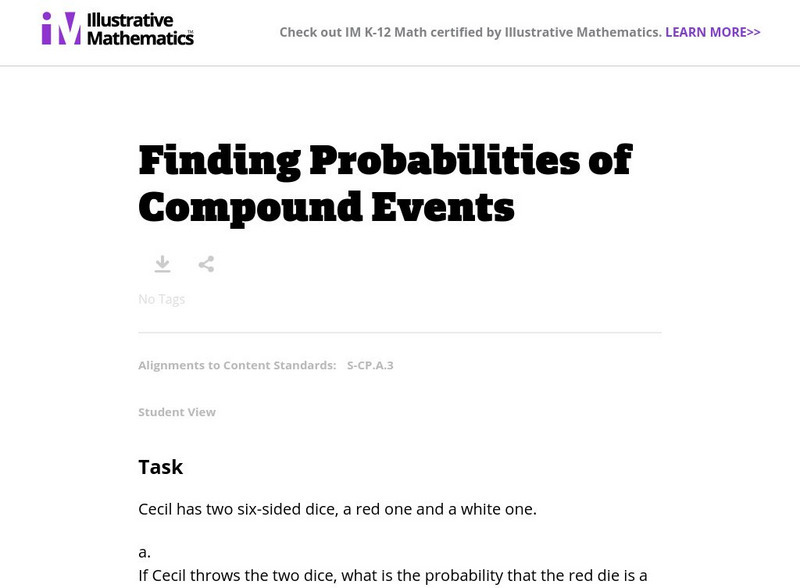Hi, what do you want to do?
Curated OER
Take A Chance Or Two
A two-part lesson immerses young statisticians in the concept of probability. On the first day, will conduct experiments with a two-colored coin and learn how to write probabilities as fractions, ratios, and percentages. In the second...
Curated OER
Roll On Down!
Students create number sentences by rolling two dice. Each student rolls the dice and writes down the numbers in number sentence format. Then they add the problem by using the strategies of counting on and doubles.
Curated OER
Radon Alert: Understanding Odds
In this radon alert: understanding odds worksheet, 5th graders predict results of rolling dice and record data in a chart, then compare odds of events and occupations, then compare that with radon exposure.
Curated OER
Unexpected Answers
Students consider probability problems with unexpected and surprising answers.
Curated OER
Chance Dance Compositions
Fourth graders create dances through a randomly generated process (such as throwing a dice) and perform their dances for the class. Class work is based on Merce Cunningham's "Chance Dance" and includes walking, skipping hopping, and...
Curated OER
What Are the Risks?
Middle schoolers use dice to determine the risk of being exposed to radon. They practice using new vocabulary related to probability and ratios. They make predictions about the results and record their observations.
Curated OER
The Fair Factor
Students participate in playing many games to determine if they are fair or not. They create their own game that is fair to play with their classmates.
Curated OER
Dominoes
Fourth graders solve a dominoes word problem, calculating all the possible outcomes for a sequence of events. They discuss the problem, apply counting strategies, create a tree diagram, and write an explanation of how they solved the...
Curated OER
Not In My Backyard: The Nature and Danger of Nuclear Radiation
High schoolers evaluate the ways to control exposure to radiation and determine how to deal with the problem of nuclear waste in a rational rather than an emotional way.
Curated OER
Number Sense
Eighth graders participate in a lesson that is concerned with reviewing basic math concepts using the four operations. The activity is composed of a math game that is played by them.
Curated OER
Statistics and Probility
Seventh graders collect data and make predictions. In this geometry lesson, 7th graders work in tiers collecting data and plotting it. They make inferences and predictions about their collected data.
Curated OER
What's Ponytail's Big News?
Students discuss reasons to not smoke. In this anti-smoking lesson plan, students listen to a story where the character Ponytail the pony doesn't smoke and is thus able to engage in physical activities. They create Ponytail's pinwheel...
Curated OER
Thanksgiving: Traditions
Young scholars investigate the traditions and history around Thanksgiving. They divide into groups and research specific aspects of the holiday. Students then share their findings with the rest of the class. They also complete crafts,...
Curated OER
Rules of Sign Change
Young scholars manipulate negative and positive numbers. In this integers lesson, students move through three activities exploring negative and positive whole numbers. A number line, cardboard function representation, and solving...
Shodor Education Foundation
Shodor Interactivate: Dice Table
A dice-table activity introduces students to probability and to converting probability to a simple fraction, a decimal, and a percentage.
Illustrative Mathematics
Illustrative Mathematics: 7.sp Rolling Dice
Roll two dice 10 times. After each roll, note whether any sixes were observed and record your results in the table below. Aligns with 7.SP.C.7.
Illustrative Mathematics
Illustrative Mathematics: S cp.a.3: Finding Probabilities of Compound Events
Cecil has two six-sided dice, a red one and a white one. Aligns with S-CP.A.3.
Illustrative Mathematics
Illustrative Mathematics: 7.sp.8 Tetrahedral Dice
Many games use dice which are six-sided and fair (meaning each face on the die is equally likely to land face up). Many games also use the sum of two dice rolled at the same time to determine movement of game pieces. However, not all...
PBS
Pbs Mathline: Remove One Lesson Plan [Pdf]
Students play a game involving chips, dice, and a number line to explore the outcomes of events. Printable lesson.
University of Texas at Austin
Mathematics Teks Toolkit: Rolling Races
Students play a game by rolling dice and determining the probability of outcomes of colors.
Other popular searches
- Dice and Probability
- Dice Probability
- Math Probability Dice
- Probability Dice Games
- 2 Dice Probability
- Probability and Dice Graph
- Probability Dice and Cards
- Dice Probability Tree
- Probability Dice Roll
- Probability Dice and Coin
- Dice Probability Odds
- Probability Dice Activity





















